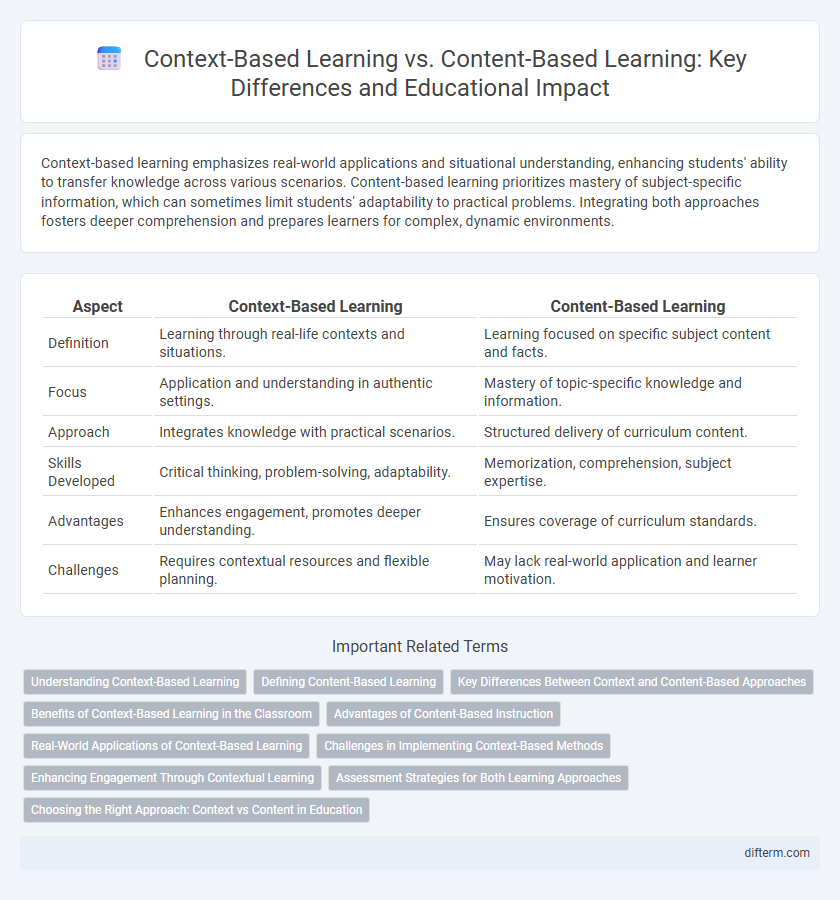Context-based learning emphasizes real-world applications and situational understanding, enhancing students' ability to transfer knowledge across various scenarios. Content-based learning prioritizes mastery of subject-specific information, which can sometimes limit students' adaptability to practical problems. Integrating both approaches fosters deeper comprehension and prepares learners for complex, dynamic environments.
Table of Comparison
| Aspect | Context-Based Learning | Content-Based Learning |
|---|---|---|
| Definition | Learning through real-life contexts and situations. | Learning focused on specific subject content and facts. |
| Focus | Application and understanding in authentic settings. | Mastery of topic-specific knowledge and information. |
| Approach | Integrates knowledge with practical scenarios. | Structured delivery of curriculum content. |
| Skills Developed | Critical thinking, problem-solving, adaptability. | Memorization, comprehension, subject expertise. |
| Advantages | Enhances engagement, promotes deeper understanding. | Ensures coverage of curriculum standards. |
| Challenges | Requires contextual resources and flexible planning. | May lack real-world application and learner motivation. |
Understanding Context-Based Learning
Context-based learning emphasizes the application of knowledge within real-world scenarios, enhancing critical thinking and problem-solving skills. This approach contrasts with content-based learning, which prioritizes the memorization of facts and information without situational relevance. By integrating practical contexts, learners achieve deeper comprehension and retain information more effectively.
Defining Content-Based Learning
Content-based learning centers on teaching language through subject matter that develops students' knowledge and skills in specific academic disciplines, such as science or history. It integrates language acquisition with content mastery, promoting comprehension and communication within real-world contexts. This approach enhances cognitive engagement by linking language instruction directly to meaningful and relevant material.
Key Differences Between Context and Content-Based Approaches
Context-based learning emphasizes understanding concepts through real-world situations, enhancing critical thinking and application skills. Content-based learning focuses on mastering specific subject matter, prioritizing the acquisition of factual knowledge and structured information. The key differences lie in context-based approaches promoting experiential understanding and adaptability, while content-based methods concentrate on systematic curriculum delivery and knowledge retention.
Benefits of Context-Based Learning in the Classroom
Context-based learning enhances student engagement by connecting lessons to real-life scenarios, improving comprehension and retention. This approach fosters critical thinking and problem-solving skills as learners apply knowledge in meaningful contexts. Teachers report increased motivation and deeper understanding compared to traditional content-based learning methods.
Advantages of Content-Based Instruction
Content-Based Instruction (CBI) enhances language acquisition by integrating subject matter learning with language development, promoting deeper cognitive engagement. This method supports the retention of vocabulary and concepts by contextualizing language within meaningful academic content such as science or history. CBI fosters motivation and practical language use, as students apply their skills to real-world topics, improving both comprehension and communication proficiency.
Real-World Applications of Context-Based Learning
Context-based learning emphasizes real-world applications by integrating academic content with practical scenarios, enhancing students' ability to apply knowledge in authentic contexts such as problem-solving in science and social interactions in language learning. This approach fosters critical thinking, adaptability, and relevance, linking theoretical concepts to everyday experiences and professional challenges. Research shows that context-based learning increases student engagement, retention, and the development of transferable skills compared to traditional content-based methods.
Challenges in Implementing Context-Based Methods
Implementing context-based learning presents challenges such as the need for educators to design curriculum that integrates real-world scenarios while aligning with standardized academic content. Teachers often require additional training and resources to effectively facilitate context-driven lessons that cater to diverse learner backgrounds and interests. Furthermore, assessing student performance in context-based learning can be complex, as traditional testing methods may not fully capture applied knowledge and critical thinking skills developed through this approach.
Enhancing Engagement Through Contextual Learning
Context-based learning enhances engagement by immersing students in real-world scenarios that relate directly to the subject matter, fostering deeper understanding and retention. Unlike content-based learning, which focuses on memorizing facts, context-based approaches encourage critical thinking and practical application of knowledge. This method leverages situational relevance to motivate learners, leading to improved cognitive connections and long-term academic success.
Assessment Strategies for Both Learning Approaches
Assessment strategies for context-based learning emphasize real-world problem-solving and application of knowledge in authentic scenarios, often using project-based evaluations, peer assessments, and formative feedback to gauge understanding. Content-based learning assessments typically focus on measuring retention and mastery of specific subject matter through quizzes, standardized tests, and summative evaluations. Balancing both approaches requires integrating practical tasks with traditional assessments to effectively measure students' comprehension and ability to transfer knowledge across contexts.
Choosing the Right Approach: Context vs Content in Education
Choosing between context-based and content-based learning hinges on educational goals; context-based learning enhances critical thinking and real-world application by situating knowledge within relevant scenarios, while content-based learning emphasizes mastering specific subject matter and factual information. Context-based approaches foster deeper engagement and adaptability, particularly beneficial in disciplines requiring problem-solving skills and interdisciplinary understanding. Content-based learning remains essential for foundational knowledge acquisition, especially in standardized curricula and exams.
context-based learning vs content-based learning Infographic

 difterm.com
difterm.com